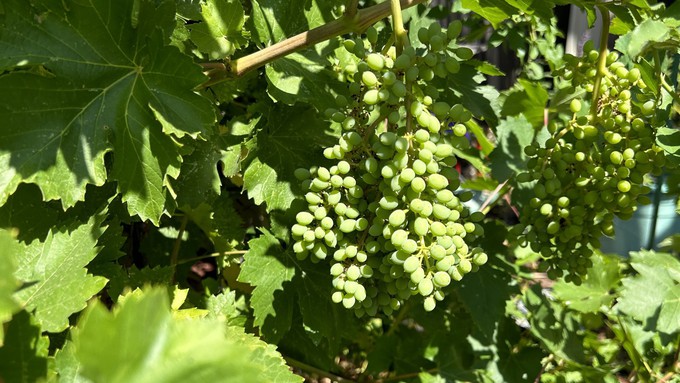
June ends with a warming trend; triple digits coming soon

Grapes grow larger with some pruning of fruit. At the very least, trim the last 2-3 inches off the bunches. (These already have been done.) Kathy Morrison
Prepare to get hot. According to the National Weather Service, June closes out with a warming trend. After several days of below-normal temperatures, this week’s afternoon highs will zip up to almost 100 degrees by Friday. That’s a 20-degree swing in just seven days.
This past week, Sacramento enjoyed four afternoons in the high 70s – 10 degrees below our late June average. Friday’s expected 99 degrees is 10 degrees above.
Friday likely will the hottest day of 2023, so far. Sacramento saw 94 degrees on June 4 and 95 on May 13. (Those were both records for those dates.) But otherwise, we’ve been relatively chilly.
But this coming 20-degree jump in high temperatures can stress fast-growing plants. Make sure your summer vegetables are deeply watered. Don’t let tomatoes, peppers, squash or eggplant dry out.
One good thing about this coming heat wave: It should wipe out powdery mildew and similar fungal diseases. They can’t stand temperatures above 95 degrees.
Meanwhile, concentrate on keeping your plants and yourself comfortable.
* Let the grass grow longer. Set the mower blades high to reduce stress on your lawn during summer heat. To cut down on evaporation, water your lawn deeply during the wee hours of the morning, between 2 and 8 a.m.
* Mulch, mulch, mulch! This “blanket” keeps moisture in the soil longer and helps your plants cope during hot weather.
* Trim off dead flowers from rose bushes to keep them blooming through the summer. Roses also benefit from deep watering and feeding now. A top dressing of aged compost will keep them happy. It feeds as well as keeps roots moist.
* Avoid pot “hot feet.” Place a 1-inch-thick board under container plants sitting on pavement. This little cushion helps insulate them from radiated heat.
* Tie up vines and stake tall plants such as gladiolus and lilies. That gives their heavy flowers some support.
* Dig and divide crowded bulbs after the tops have died down.
* Feed summer flowers with a slow-release fertilizer.
* Thin grapes on the vine for bigger, better clusters later this summer.
* Cut back fruit-bearing canes on berries after harvest.
* Feed camellias, azaleas and other acid-loving plants. Mulch to conserve moisture and reduce heat stress.
* Cut back Shasta daisies after flowering perennials to encourage a second bloom in the fall.
* Pinch back chrysanthemums for bushier plants with many more flowers in September.
* From seed, plant corn, pumpkins, radishes, squash, melons and sunflowers.
* Plant basil to go with your tomatoes.
* Transplant summer annuals such as petunias, snapdragons, marigolds and zinnias.
* It’s also a good time to transplant perennial flowers including astilbe, columbine, coneflowers, coreopsis, dahlias, rudbeckia, salvia and verbena.
Comments
0 comments have been posted.Sacramento Digs Gardening to your inbox.
Sites We Like
Garden Checklist for week of May 5
Survey your garden after the May 4 rainstorm. Heavy rain and gusty winds can break the neck of large flowers such as roses. Also:
* Keep an eye on new transplants or seedlings; they could take a pounding from the rain.
* Watch out for powdery mildew. Warmth following moist conditions can cause this fungal disease to “bloom,” too. If you see a leaf that looks like it’s dusted with powdered sugar, snip it off.
* After the storm, start setting out tomato transplants, but wait on the peppers and eggplants (they want warmer nights). Pinch off any flowers on new transplants to make them concentrate on establishing roots instead of setting premature fruit.
* Trim dead flowers but not leaves from spring-flowering bulbs such as daffodils and tulips. Those leaves gather energy to create next year's flowers. Also, give the bulbs a fertilizer boost after bloom.
* Pinch chrysanthemums back to 12 inches for fall flowers. Cut old stems to the ground.
* Mulch around plants to conserve moisture and control weeds.
* From seed, plant beans, beets, cantaloupes, carrots, corn, cucumbers, melons, pumpkins, radishes and squash.
* Plant onion sets.
* In the flower garden, plant seeds for asters, cosmos, celosia, marigolds, salvia, sunflowers and zinnias. Transplant petunias, zinnias, geraniums and other summer bloomers.
* Plant perennials and dahlia tubers for summer bloom.
* Don’t wait; plant summer bulbs, such as gladiolus and tuberous begonias.
* Harvest cabbage, lettuce, peas and green onions.